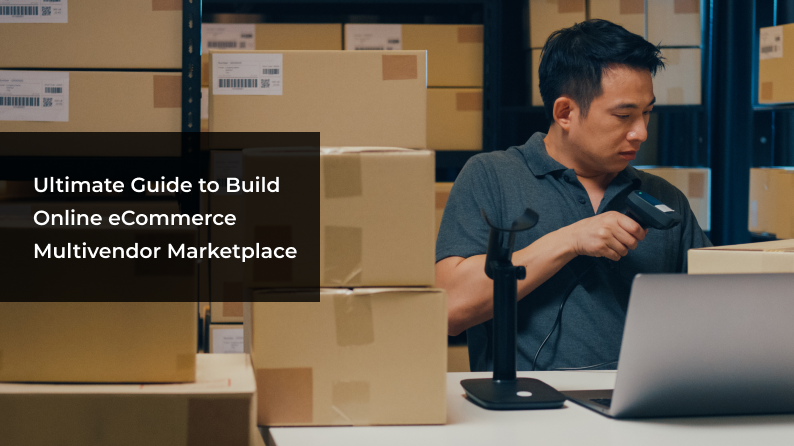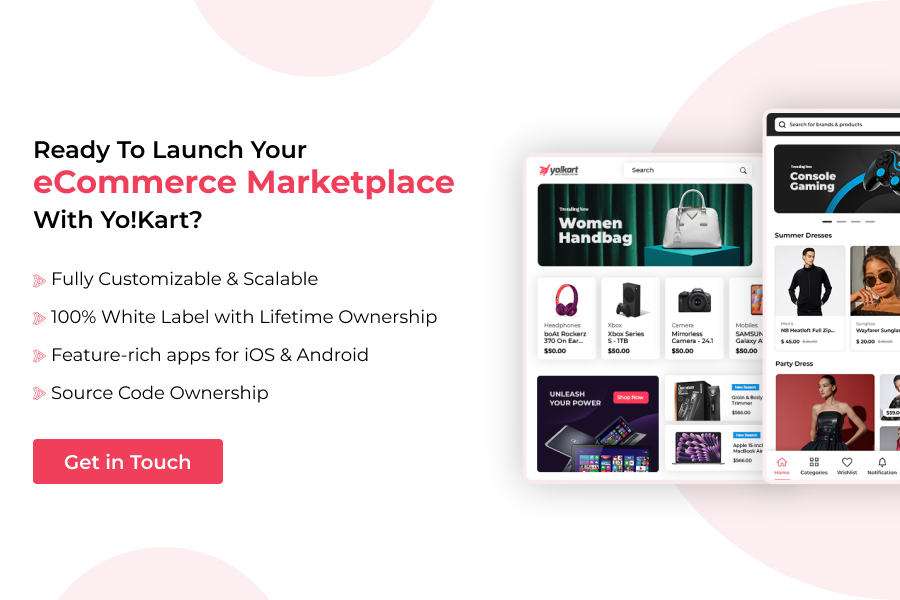Updated On: 7th Aug 2024
According to Statista, Amazon alone accounts for a sizeable 37.6% of all online retail sales i.e. one out of every third of users prefers it over every other eCommerce website. The success is not limited to Amazon alone. Globally, e-marketplaces like Amazon, Taobao, Etsy, Lazada, and Trendyol are fueling online retail transformation in their respective regions.
Looking at the success of such websites, you must have wondered: How can I build an eCommerce marketplace of my own? The answer lies in understanding the online retail industry, analyzing your options and following a series of steps. Read this article for complete information on how to build an online multivendor marketplace.
Table Of Contents
- What is an Online Multivendor Marketplace and how do they Work
- Why are Online Multivendor Marketplaces So Popular?
- What are the types of Multivendor Marketplaces
- Popular Niches to Start your Multivendor Marketplace
- How do eCommerce Multivendor Marketplaces earn Money?
- Which eCommerce Marketplace Features are a must-have for your eCommerce Business?
- What are the Steps to Build Online Multivendor Marketplace?
- What is the Cost to Build eCommerce Marketplace Platform?
- The Advantage of Yo!Kart
- Wrapping Up
What is an online multivendor marketplace and how do they work?
Traditionally, in the offline ecosystem, a product would move through multiple businesses, from the manufacturer to the retailer that sells the product to the buyer. These businesses would include distributors, wholesalers, stockists, and more. This is called a “supply chain” of a particular product. Since the product has to be sold via immovable physical outlets, there is no way to bypass this chain of businesses involved.
Online multivendor marketplaces like Amazon changed this whole concept. They launched a digital platform on the internet connecting sellers with buyers. This platform would allow any seller to onboard, list their products, and sell them to the consumers. So businesses across the supply chain now had an opportunity to sell to the buyers. Even the manufacturer can directly sell to the buyer via Amazon. Here, Amazon itself is the only middleman. In other words, An online multivendor marketplace is a platform that digitizes the middleman, allowing any seller to sell products directly to the consumers. This is how it works.
- A multivendor marketplace is a digital platform by an intermediary party.
- They arrange backend operations like shipping, payment, and taxation.
- They invite the sellers i.e. onboard them
- The sellers now sign up and list the products they wish to sell.
- Buyers sign up and search for the products.
- Finalize the product, and complete the checkout process by paying for the product.
- After the buyer completes the transaction, the Admin arranges shipping from the seller to the buyer.
Why are Online Multivendor Marketplaces So Popular?
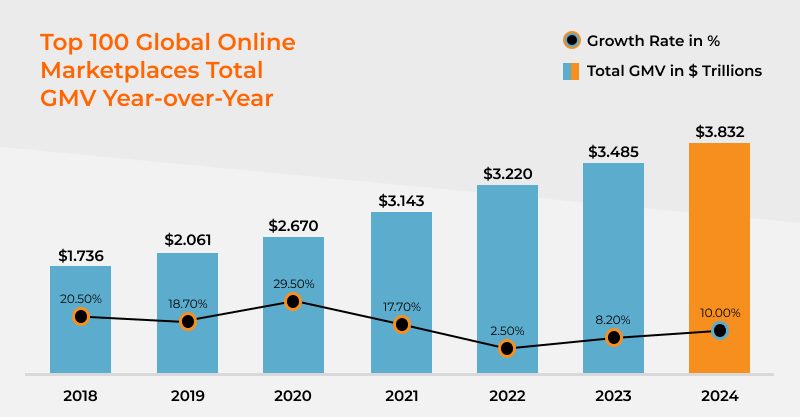
Credits: Digital Commerce 360
Online multivendor marketplaces have maintained an increasing growth rate of 10% in 2024. The Gross Merchandise Volume has been steadily rising, amounting to $2.8 trillion. Because of the benefits of multivendor marketplaces―these supersede both offline sales and other eCommerce websites. Let’s analyze these advantages below:
Benefits for you, the business owner
When Jeff Bezos first launched Amazon, it was an online store for books. It was only a few years later, he realized the benefits of a multivendor marketplace, and the rest is history. There are other such examples as well. For instance, the Alibaba-owned South East behemoth Lazada, scaled from an online store to a multivendor marketplace to find sustained success. The following is the value a multivendor marketplace business model can offer for you.
No-inventory: In a multivendor marketplace the third-party sellers maintain an inventory. The marketplace owner takes care of the operations. So a critical dependency is avoided.
Scalability: With multiple sellers and products, multivendor marketplaces have a greater opportunity to scale, in terms of a broader user base, portal traffic, sales, and geographic reach.
More revenue generation options: Instead of just profit margins on products, you will have the opportunity for more revenue streams. More on this later in the blog.
Sales are higher in multivendor marketplaces: According to Wharton, University of Pennsylvania, another reason multivendor marketplaces have higher sales is due to the Bandwagon and Network effects. This means that consumers attach more value to a product their peers are purchasing. For instance, consumers tend to buy more in an eCommerce marketplace when the rating is good and the number of reviews is more.
Suggested Read: Why online stores scale to multivendor operations
Benefits for the sellers
Sellers with varying goals prefer multivendor marketplaces. For instance, brick-and-mortar retailers may need lesser operational dependency. A multivendor marketplace offers them an easy route to expand sales. Similarly, those with an online store may want an additional presence, that catalyzes their existing sales. Moreover, many sellers simultaneously sell on various multivendor marketplaces. All these sellers prefer an online marketplace because of these benefits:
- Multivendor marketplaces give them a readymade user base.
- Setting up online sales is easier, without an operational dependency mandate.
- Established e-marketplaces allow new sellers to set up their brand equity.
- With the presence of related products the chances of conversions are higher.
Benefits for buyers in a multivendor marketplace
Many buyer journeys start at Amazon. Interestingly, apart from being a multivendor marketplace, it also serves as a search engine for many consumers beginning their shopping! This shows the value the eCommerce behemoth has been able to place in consumers’ lives. Similarly, other multivendor marketplaces also have the opportunity to gain the buyers’ attention. Let’s see why:
- A wider choice of products, categories of products, brands, and sellers.
- The presence of reviews and ratings from their peers.
- Since e-marketplaces digitize the middleman, shortening the supply chain, they are able to offer products at lower prices. This is one of the key motivations behind online shopping.
Launch an eCommerce marketplace to encash their popularity
What are the types of multivendor marketplaces
Amazon, Alibaba, and Etsy are all multivendor marketplaces, but yet they are different. What is this difference? Before you build an online multivendor marketplace, you can know their types. Some popular types that you may have come across are
- B2C (where sellers are businesses and buyers are consumers) i.e. Amazon
- B2B (where both sellers and buyers are businesses) i.e. Alibaba
- C2C (where both sellers and buyers are consumers) i.e. Etsy
But this is just the start. Multivendor marketplaces can be of multiple types. Let’s learn the complete list below:
| Based on the following Parameter | Different types of Marketplaces | Examples of Popular Players, based on this type |
| Types of Sellers and Buyers in a Marketplace | B2C marketplace: The most popular use case. In this, the sellers are businesses/retailers. The buyers are consumers. | Amazon, Newegg |
| C2C marketplace: The easiest to set up use case: In this users can register as buyers or sellers and transact with each other. | Etsy, eBay | |
| B2B marketplace: An upcoming use case with least competition: In this both the buyers and sellers are businesses. | Alibaba, Procurenet | |
| Product Categories | Horizontal marketplace: These offer multiple product categories from varying industries. Consumers can buy electronic products or fashion items at the same time. | Amazon, Alibaba |
| Vertical marketplace: These offer products from a single industry for easier marketing and better brand differentiation. | Etsy, Newegg, ASOS | |
| Product type | Physical products marketplace: These let vendors sell tangible or physical products | Newegg, Walmart |
| Digital Products marketplace: These facilitate the selling of downloadable digital products. | Kindle, Envato | |
| Target Region | Global Marketplace: An e-marketplace that has no operative geographical restriction. | Etsy, Newegg |
| Hyperlocal Marketplace: These operate within a local area only, typically offering faster deliveries. | Instacart | |
| Transaction Types | Fixed retail price: In these marketplaces, the retail prices of products are fixed. | Amazon |
| Negotiable transactions: These marketplaces allow buyers to negotiate prices with the sellers. | Vinted |
Popular Niches to Start your Multivendor Marketplace
As we discussed in the types of eCommerce marketplace platforms, there are two ways businesses choose which industry(s) to operate in. Horizontal e-marketplaces like Amazon offer products from multiple industries. However, e-marketplaces like Etsy operate in a more defined space i.e. offering products from one industry vertical or a niche.
This has helped Etsy define its operations and brand in a more exclusive space. Over the years, multiple eCommerce businesses have adopted this niche eCommerce strategy for success. These are some of the more popular Niches in the eCommerce industry.
1. Fashion: This has been an industry of choice for eCommerce businesses. Fashion products have a broad target audience, simpler logistics, and a varied SKU range attracting multiple sellers. However, returns can be higher, and competition can be more. Notably, building a B2B fashion marketplace is a lucrative opportunity as well. Examples: ASOS, FarFetch, StockX, Zalando.
2. Digital Goods: A niche with a low barrier to entry, digital goods online marketplaces can offer ebooks, digital creatives, music, themes, stock photos, and more. Significantly, operations like shipping are not involved, so this niche is simpler than others. Examples: Envato marketplace, Regake, Freepik.
3. Homeware (Home & Kitchen items): Since the pandemic a few years ago, home decor has been a priority for consumers. This vertical also includes a varied SKU range appealing to a broad range of consumers for various purposes, so there are multiple ideas to start a homeware marketplace. Examples: Wayfair, HomeDepot, Lampwelt.
4. ReCommerce: A popular niche, especially for those who want to build a C2C eCommerce marketplace. This can connect consumers looking for better-priced items and those who wish to monetize belongings they no longer need. Moreover, with sustainability gaining traction as an imperative, eCommerce marketplaces with this theme have a good opportunity. Examples: Swappa, Mercari.
5. CBD Marketplace: CBD, a non-psychoactive compound has been found to alleviate anxiety and pain by some researchers. So many wellness products such as oils, gummies, cookies, and more. The sale of CBD products attracts both consumers and suppliers, especially in countries such as the US. Naturally, CBD niche marketplaces are a good business proposition. Examples: CBD.Market, BuyCBDSupps.
Suggested Read: Top 12 niches in eCommerce and how to choose
Build a niche specific eCommerce marketplace
How do eCommerce multivendor marketplaces earn money?
Finances are key to any business. Before pondering how to build your online multivendor marketplace―focus on this. Such a business will give you 2 revenue generation systems, primary and secondary. These are the primary revenue streams:
Commissions: The business levies a fixed percentage of sales as commission for all products/services sold on an eCommerce marketplace. This is either fixed or variable.
Product Listing: A fee for listing products on the eCommerce platform is charged.
Subscription plans: eCommerce marketplace businesses can offer subscription plans for their users. These generally come with bundled services.
Monetizing advertisements: Website real estate can be offered to the sellers for advertising their products. This is in exchange for a fee. For instance, Amazon provides this opportunity for both sellers on their platform and brands that don’t operate on it.
The secondary revenue streams come from offering services. For instance, some popular players earn revenue via these channels:
- Amazon earns via its fulfillment services, AWS, and more.
- Etsy has a service called “Pattern” which assists its customers in building an additional website in exchange for a recurring fee.
- Lazada offers its in-house eLogistics services to the sellers.
Interestingly, you might come across sources conveying that payment gateway charges and affiliate marketing are revenue channels for an eCommerce marketplace. But this is only partially accurate. Payment gateway providers levy charges in exchange for using their services. So unless the payment gateway is in-house developed and owned by the business, these charges are transferred to the payment gateway providers. (More on this in the next section). Similarly, Affiliate marketing is a marketing strategy to attract more users/traffic. (We’ll discuss this in the steps for How to build an online multivendor marketplace).
Which eCommerce marketplace features are a must-have for your eCommerce business?
To run your eCommerce business successfully, you will need the right tools. These tools are the features in the eCommerce multivendor marketplace. These aid in the effective operations of the business, foster better selling from the vendors and allow buyers an engaging shopping experience. These features are similar to those offered by established players like Amazon or Etsy. First, Let’s look at some of the essential features for better operations.
Features for the operator of the eCommerce marketplace platform(Admin):
User Management: For facilitating smooth user operations, a marketplace operator needs tools to vet seller onboarding requests, manage their onboarding, monitor presence on the platform, approve requests, and more.
Product Catalog Management: This allows the marketplace operator to have regulatory control over the products sold in the platform. This can include adding details of the product, their descriptions and specifications, tax and shipping-related information, and more.
Shipping Management: A key component of seamless eCommerce experiences, shipping needs to be conducted smoothly, with key information availability, and with access to the best possible prices. This is done with shipping management features in the platform.
Marketing & Platform promotion: Upselling functionalities like volume discounts and coupons; cross-selling functionalities such as buying together contribute to enhancing sales on the platform. Moreover, some key tools such as meta tags rewriting, image attributes, and more.
Effective Affiliate Marketing: Under this program, an eCommerce business offers Affiliate partnerships. These partners direct users direct traffic to the eCommerce platform via their various digital marketing initiatives. For each sales conversion via this directed traffic, the eCommerce business rewards the affiliate partner with a commission.
To make this program more effective, the eCommerce marketplace can offer its affiliate partners a dedicated user panel on the platform that gives the capabilities to track their performance.
Features for the sellers of the eCommerce marketplace platform:
Individual Seller Storefront: A pivotal feature, this allows sellers to have their space within the platform. Just like on marketplaces like Amazon, here all the products listed by the seller are displayed in the same page. Furthermore, the sellers can have the ability to brand the page as per their requirements.
Inventory Management: Business operations are easier for the sellers with effective inventory management tools. Here holistic inventory reports with useful functionalities like low stock alerts aid operational efficiency.
Order management: Sellers need effective capabilities to manage orders once they have been placed by the buyers. Some key of these are easily accessible order details, managing returns, and more.
Reports and Analytics: For any eCommerce marketplace, data plays a key role in effective decision-making. Reports and analytics feed this data to both the sellers and the marketplace operator.
Features for the buyers of the eCommerce marketplace platform:
Intuitive UI/UX: Buyers need quick, convenient, and easily navigable UI for a satisfying shopping experience. Moreover, the placement of various website elements also fosters higher user engagement.
Multiple payment methods: Buyers can have varied preferences for how they wish to pay for the orders. Including popular payment methods like card payment, bank transfers, eWallets, and others is essential for higher conversions on the eCommerce marketplace.
Review & Ratings: The capability to add reviews and ratings for their purchased has two benefits. First, it engages the users and second it plays a key role in their decision making while committing to a purchase.
Advanced Search Bar: As attention span keeps reducing in general, it is important for all digital engagement to be as efficient as possible. Here, an advanced search bar in the system is key for users to find the desired products quickly and accurately.
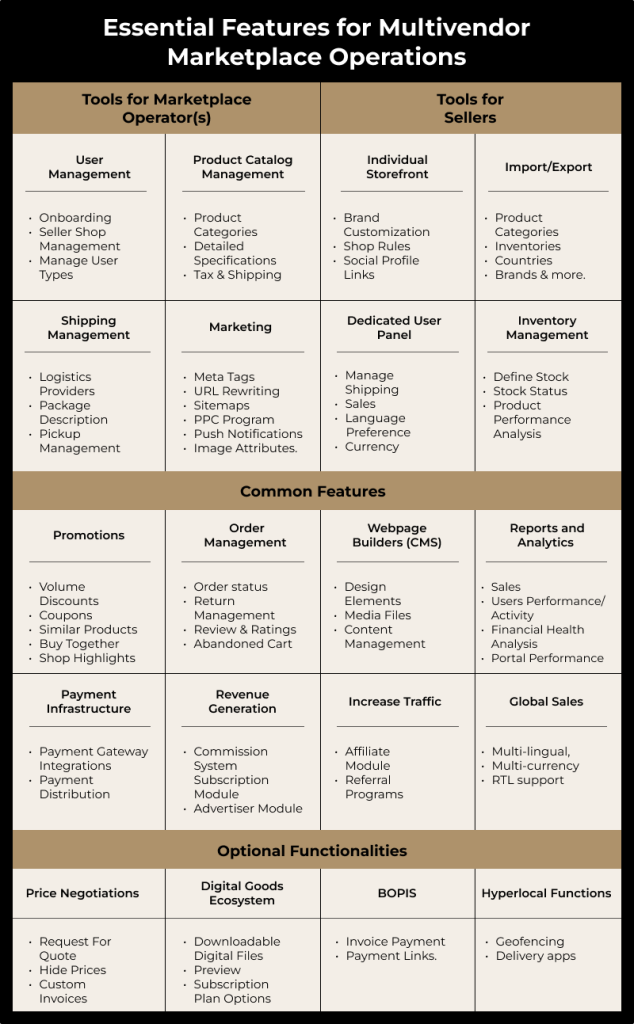
In addition to these features, many eCommerce operations are assisted by third-party solutions. For instance, consider these business solutions:
- Payment Gateways (for transactions on the eCommerce marketplace)
- Mailchimp (for automated email marketing)
- Avalara (for tax management)
- Shipstation (to aid eCommerce fulfillment)
- HeyZilo (to offer customer services)
These are some examples of business solutions that help in critical business functions from payment processing to marketing. These processes can be automated. These solutions offer APIs, that can be integrated with your eCommerce marketplace. For this reason these are also referred to as “eCommerce APIs”
Moving on, consider the following imperatives to give the third (but not the least) most important participant in your eCommerce business i.e. the consumers―an engaging ecosystem.
- Engaging UI/UX
- Streamlined Workflows
- Seamless Checkout
- Opportunity to interact such as ratings/reviews, social media sharing, and more.
What are the Steps to Build Online Multivendor Marketplace?
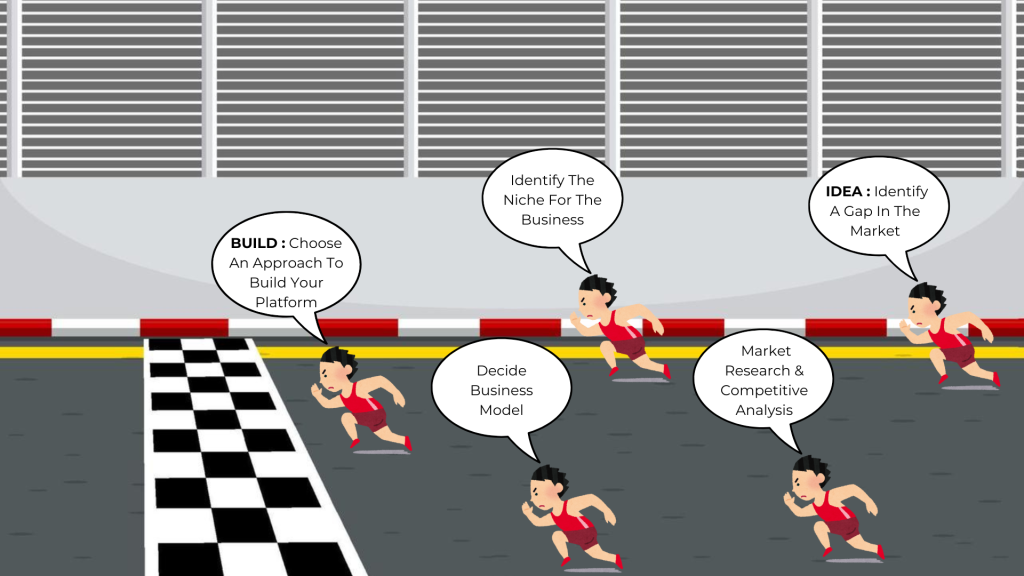
The best way to understand a complex initiative is to break it down into smaller and achievable smaller steps. If you wish to know how to build an online multivendor marketplace, divide the process into smaller steps. The same are discussed below.
Step 1 – Idea: Identify a gap in the market
Let’s take the example of Etsy. Before the marketplace came into being, the founders used to work as website developers. While working on a project, they realized that the existing eCommerce marketplaces like eBay could not cater to the needs of a specific set of sellers and buyers. So they launched an eCommerce platform to cater directly to these needs.
Another example is Lazada. The website is modeled on the lines of Amazon. Even back in 2012, It would have taken something special for an idea like this to work in western markets. So the fouder, Max Bittner, chose a region that has the essentials but lacks eCommerce platforms i.e. South East Asia. The idea worked and Lazada’s success has been inspiring.
There are multiple examples: Airbnb, Uber, and many more. The idea for a new eCommerce marketplace venture can come by identifying a a specific problem for buyers in a specific industry. The next thing is identifying supply i.e. a potential vendor base with the capacity to cater to new set of consumers.
Once there is a list of such ideas, the next thing would be to conduct a market research.
Have a Great eCommerce marketplace idea in mind? Trust us to deliver
Step 2 – Market Research and Competitive Analysis
A complete market research and competitive analysis is necessary to learn some of these pivotal drivers for your business. Expect on these outcomes:
- Get a thorough analysis of the target audience: their needs and desires. An analysis into what they value is most important.
- Understand the competition: Analyze your competitors thoroughly. Their business model, how they attract sellers why do the sellers like using the platform, pricing strategy of the products, value-added services liked by the sellers, and likewise traction points for the buyers.
- Evaluate your barrier to entry in the market keeping in consideration resources currently available to you.
Achieve this via the following eCommerce market research best practices:
- Conduct market surveys. Also, observe any other existing surveys.
- Observe online discussion forums and interaction on social media platforms, concerning your focus area.
- Conduct an internal audit. Find your advantages and leverage them. For instance, Amazon is a leading player with an early mover advantage. Still, Walmart gained a significant market share by leveraging its internal assets across the US.
- Analyze your competitors’ eCommerce websites. Which features enhance user experience?
- Understand their business model and revenue generation strategies.
- Conduct an extensive analysis of your competitors’ assets online. Analyze which keywords and search queries they rank on SERPs.
- Examine the current industry trends.
Build an online multivendor marketplace with contemporary eCommerce features
Step 3 – Identify a niche for the business
We explored the value of starting with an industry niche in multiple instances in this guide. The reason is that it is a critical eCommerce strategy in the current scenario. It will allow for a measured yet purpose-driven start. Moreover, it will let you reach out to a specific audience with a tailored solution, enhancing the chances for success. Apart from going through the above-mentioned best practices, consider the following.
- Identify market trends, both current and potential. For instance, sustainability, veganism, and fitness are priorities for consumers.
- Gauge for long-term business viability and scalability.
Step 4 – Decide business model
Analyze which business model works best for your business idea. It may be different than what the existing competition offers. For instance, if you are considering competing within the fashion industry with a strong B2C player, consider starting a e-commerce C2C marketplace. Similarly to compete against a national competitor like Amazon, try launching a hyperlocal marketplace that promises faster delivery and personalized attention that Amazon cannot.
Similarly, decide on the revenue available, and the ones that works best for your business idea.
Step 5 – Choose an approach to build your platform
In your quest to understand how to build an online multivendor marketplace platform, let’s move from preparation to execution. There are multiple ways you can achieve this, let’s move from the traditional to the more popular.
Approach 1: Bespoke eCommerce Marketplace Development
The first method is building the eCommerce multivendor platform right from scratch. Your website will be coded from scratch. If you partner with some of the leading names in the development industry, they will discuss your requirements, analyze your needs, and chalk out a development strategy. Further, the marketplace will be tested at each step and deployed. Since this will be a new system, you may need support from the team after the solution has been deployed. All this means resources and an extended go-to-market. Each of these processes will take up the man-hours of the partner team. Eventually, you will be billed for these hours, leading to a significant investment of resources.
Approach 2: Open Source Solution Customization
As a consumer, you must have observed, a certain sameness to most popular eCommerce marketplace platforms. Fundamentally, there will be similarities and certain differences as well. Open Source solutions such as Prestashop are freely available software. These have the basic structure of an eCommerce marketplace platform. These give businesses a pre-built core to build their online multivendor marketplace. These solutions are further customized according to their business requirements. The customization services for open-source eCommerce software are provided by an eCommerce development company or the software provider.
However, there are some trade-offs
- Here the customization partners and the open-source software are equally important. Finding the right eCommerce development company that understands the software and your business requirements is key.
- Since the source code software are freely available. Hackers and other parties with malicious intent have access to these as much as you do.
Approach 3: SaaS eCommerce Store Solutions with Extension
SaaS eCommerce store solutions are pre-built solutions that allow you to launch an online store like the Apple store. These are already deployed by the provider on their servers. You get a share by subscribing to their subscription plans. Moreover, Since an eCommerce store is a completely different business model, these solutions are not suited by default. However, some third-party extensions can assist you in turning these online store solutions into multivendor operations. That said, there can be some trade-offs, some of these are:
Recurring subscription fees: Till the time you use the services, you pay the fee. This means an impending overhead for the business.
Platform ownership: Moreover, you don’t own the eCommerce platform. The provider owns it. They give you a space till the subscription plan is subscribed.
User data Ownership: User data is one of the most pivotal assets that your eCommerce marketplace business will own. Especially, once your business scales, With SaaS solutions you don’t own that data.
Approach 4: SaaS native Multivendor Solutions
Similar to SaaS eCommerce store solutions, these are multivendor marketplace solutions that offer the capability to launch an online multivendor marketplace. Just like them, these are hosted by the provider. They offer you to start your online business by subscribing to their services. In other words, you rent the software till the time you pay the recurring rental fee.
Since these are also SaaS solutions, the trade-offs are similar. Moreover, the costs are higher for the added functionality, and restrictions can be there depending on the plan you choose.
Approach 5: Self-hosted eCommerce Marketplace Software
If you want to know how to build online multivendor marketplace that you can own, then self-hosted solutions are the answer. These are license-based standalone solutions that you can deploy on a server of your choice. The license can be purchased from the provider. The license itself can come with recurring subscriptions, however, some are also offered with a one-time payment solution. Some trade-offs are as follows:
- Some self-hosted eCommerce marketplace solutions may not offer customization, so there will be a need to look for customization providers. However, some self-hosted solutions are offered with in-house customization as well.
- Likewise, consider self-hosted eCommerce solutions that are covered by installation and after-services as well.
Bottom Line:
Depending upon your choice, self-hosted solutions can give you readymade capabilities. So entrepreneurs/business owners planning for a measured start can use them as is. Bigger businesses considering a more purpose-built launch can consider customizing these solutions. Moreover, comparing self-hosted software vs SaaS solutions, the former also gives you the flexibility to own user data.
Sounds Complicated? Trust building your eCommerce marketplace to a leading industry solution
Step 6 – Launching the Platform and marketing it
Digital Marketing is an essential business function of eCommerce marketplace businesses. An online presence means you have to work towards getting your online marketplace in front of the target audience. Some effective marketing practices are as follows.
- Optimize your online marketplace for on-page SEO for better results on SERPs
- Reach out to your audience via activities such as email marketing.
- Enhance visibility with Google Ads campaigns.
- Leverage a purpose-driven content marketing strategy.
- Work towards building user trust by regularly publishing marketing collaterals like blogs.
- Leverage a purpose-driven content marketing strategy.
- Work towards building user trust by regularly publishing marketing collaterals like blogs.
- Offer affiliate marketing opportunities by allowing affiliate partners to promote your platform products. Each conversion via this channel is compensated with partner commissions.
- Promote your business on multiple channels such as social media.
- Track the performance of your marketing campaigns with data from analytics.
Branding is the long-term association of your digital business with the target audience. It’s how they perceive your brand. All these factors impact the recall of your brand in the minds of the consumers. This is critical to set your brand in a distinct position in the competitive eCommerce market. Moreover, its also important to clearly communicate what your brand stands for to the consumers. Consider the following factors that lead to the brand equity of your eCommerce marketplace.
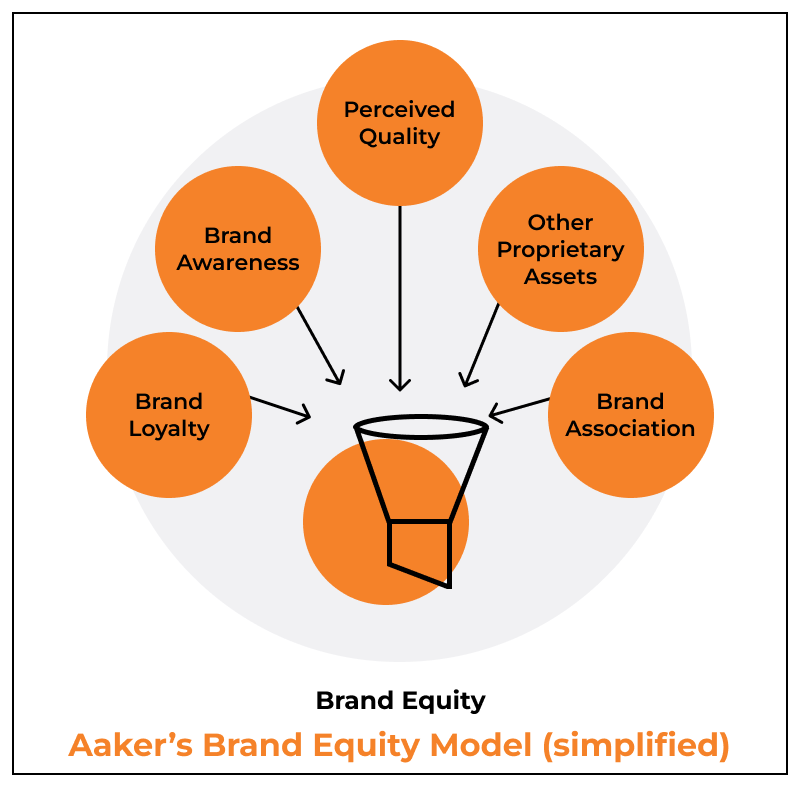
- Visual Identity of your online business which includes the logo, UI of the online marketplace, elements such as color palette, and the brand voice.
- The CX offered by your eCommerce marketplace platform.
- Experience of users, when they engage with your brand. This can include customer support and other customer-facing operations.
Effective branding helps lower customer acquisition costs, foster customer retention, and eventually boost sales for your business.
What is the cost to build eCommerce marketplace platform?
The cost to build eCommerce marketplace platform varies greatly and it depends upon the approach adopted to build the eCommerce platform.
| Approach to build eCommerce platform | Expected cost Build eCommerce Marketplace Platform |
| Bespoke eCommerce development | Variable, depends upon number of hours taken up, which depends upon project complexity, number of team members assigned, hourly rates, and more. |
| Open-source solution customization | Variable, depends upon the number of hours taken up, which depends upon project complexity, number of team members assigned, hourly rates, and more. |
| SaaS Online Store + multi vendor extension | Starts around $1,500/year for a basic plan with MVP features upto $175,000/year for better plans. Expect an additional extension price of around $499. Moreover, there are restrictions and other costs in plans for themes, extensions, and others. |
| SaaS Multivendor Marketplace | Starts around $2,400/year for the basic platform cost to about $24,000/year plus the sales fee. There are other extensions, themes, and plugin costs for every functionality. Moreover, there can be restrictions and other costs. |
| Self-Hosted eCommerce solution | Starts around $499 for lifetime ownership of the platform to about $6250. Some leading self-hosted solutions do not charge hidden/recurring charges. |
The Advantage of Yo!Kart
This article will give you an in-depth analysis of how to build online mutivendor marketplace. If you would have noticed eCommerce is not simply a buy-sell equation. We briefly touched upon multiple business functions within eCommerce. A cumulative force of these will define your success. Moreover, there are costs associated with running an eCommerce business.
Your multivendor eCommerce platform will be the unifying thread that will tie these functions. It will give you the tools to execute your plans. Moreover, it will be at the forefront, giving consumers experiences that define the future course of action.
Yo!Kart is a turnkey eCommerce marketplace software developed considering all these factors. The Yo!Kart advantage gives entrepreneurs the following benefits:
- The self-hosted solution gives entrepreneurs the flexibility to choose a server of their choice.
- It is licence-based, offered with one-time investment price packages. These also cover installation and technical support.
- Source code is available but framework is encrypted for security.
- It is customizable with support of in-house team.
- Multiple features are available with no restrictions. Business APIs are pre-integrated.
Given these advantages, the versatile solution has been the success behind 5500+ eCommerce marektplaces across the globe. Some of the these are eCommerce solutions for Fortune 500 companies, enterprise B2B marketplaces for Pharma industry, to C2C and B2C for multiple industry verticals.
Experience capabilities of Yo!Kart to build online multivendor marketplace
Wrapping up
All big eCommerce marketplaces started with an idea. The idea feuled the desire to learn how to build online multivendor platform. This is followed by a journey to disrupt the conventional, innovating with the next in eCommerce.
In this article, we have covered why and how to start an eCommerce marketplace business in detail. With this information, you can get started with bringing your idea into a business, inspired by the likes of Amazon and Etsy.
Study the market, and analyze which eCommerce marketplace platform can best fit in the current scenario. For all your needs, versatile eCommerce solutions like Yo!Kart gives you the capabilities to build an online eCommerce marketplace
FAQ:
Q1. What is a multi-vendor website?
Ans: Think of an eCommerce website like Amazon or Etsy. The website has ben designed and set up by an intermediary party like Amazon or Etsy. However, the products are sold by third-party sellers, brands, and other businesses on the platform. Such an eCommerce platform is also referred to as a multi-vendor website.
Q2. How to create a multivendor platform?
Ans: A multivendor platform can be created with the help of turnkey multivendor eCommerce solutions. These are solutions developed to mimic the operations of established eCommerce websites like Amazon or an Etsy. Moreover, depending upon which solution you choose, these can come with comprehensive plug and play capabilities. So starting with your eCommerce multivendor platform can be as easy as purchasing a solution, deploying it, and configuring it for operations.
Q3. Should I build or buy an eCommerce multivendor marketplace?
Ans: Building a website includes sharing requirements, conceptualizing the final product, building it line by line of code, and then testing it. This requires multiple development hours, ranging from a few hundred or even thousands. All these hours are billed to you. This takes up time and significant investment.
That said, most eCommerce websites have some similarities. Based on these, the industry has multiple turnkey solutions. Depending upon which you choose among these, they can let you build an online multivendor marketplace without having to code the entire website from scratch. Consequently, both time and investment resources are saved by adopting this process.
So your decision will hinge around whether what these offer is close to your business requirements. Then opting for turnkey solutions can help. If your business requirements are entirely unique, and beyond the scope of turnkey solutions, then building might be more feasible.
Q4. Which platform solution is best for a multivendor website?
Ans: Yo!Kart multivendor platform software is a leading eCommerce solution to build a contemporary e-marketplace. It offers a range of essential eCommerce features and multiple pre-integrated business APIs. Moreover, it is self-hosted and license-based, giving businesses complete control over their eCommerce marketplace platform.
